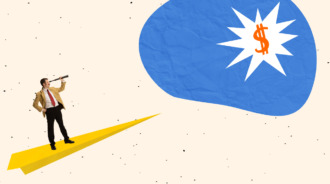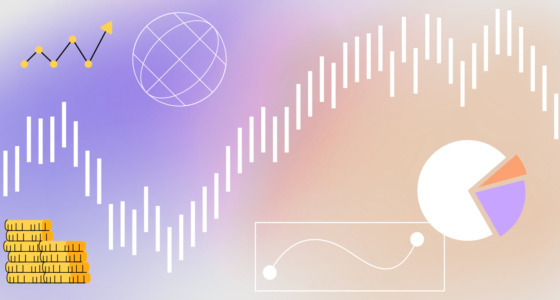

The Sharpe ratio is the most commonly used risk metric in investment performance. After all, it isn’t possible to effectively judge the overall performance of a portfolio solely on the total return. In these cases, risk-adjusted metrics are pretty useful.
The reward-to-volatility ratio is considered the most crucial factor in assessing an investment. If you feel this risk metric is something you need to know about, this guide is the right place to find out. We’ll discuss the Sharpe ratio, how to use it to calculate the reward-to-volatility ratio and articulate its importance in minimizing risk in your portfolio.
What is a risk-adjusted return?
The risk-adjusted return is a portfolio risk metric that will analyze the return of an investment based on the risk taken to achieve a return. It also considers the investment’s return and the risk of achieving it. Some standard risk-adjusted metrics include Sharpe, Sortino, Treynor, and Jensen’s Alpha ratios, but we will only discuss the first.
The measurements of risk-adjusted returns allow investors to understand if the return on investment is adequate to the risk. Usually, a higher risk-adjusted return is preferred as it identifies that the investment is generating higher returns on low risks.
However, the risk-adjusted return is just one of the many factors to consider and should be evaluated. Some of these factors include diversification, liquidity, and overall portfolio objectives.
Reward-to-volatility ratio
The reward-to-volatility ratio, in finance, is a measure of the risk-adjusted return of a stock. It is used to get an estimate of the performance of your investment relative to the risk.
Some of the common reward-to-volatility ratios are listed below:
- Sharpe ratio
It measures the excess return that is earned relative to the risk as measured by the standard deviations of the returns by the investment.
- Treynor ratio
It measures the excess return that is earned by the investment relative to the systematic risk as measured by the investment’s beta.
- Information ratio
This method will measure the risk-adjusted return of an investment relative to a particular benchmark index. It is calculated by dividing the difference between the return and benchmark return by the tracking error. The tracking error measures the deviation of the investment’s returns from benchmark returns.
- Upside potential ratio
This ratio will measure the expected return relative to its potential upside as measured by the upside deviation of returns.
- Sortino ratio
It measures the excess return that was earned by an investment relative to the downside risk measured by the downside deviation of results. It is to be noted that it will only consider the downside risk below a particular threshold, such as the risk-free rate or a target rate return.
- Sterling ratio
It measures the risk-adjusted return relative to its downside risk as measured by the semi-deviation of returns below a specific threshold.
- Calmar ratio
It is the measure of the risk-adjusted return relative to its maximum drawdown. It measures the most significant loss experienced from the peak value of the investment.
What is the Sharpe ratio?
It needed adjustments when Nobel prize winner William Sharpe introduced the Sharpe ratio. So, it has varied over the years. The Sharpe ratio measures the return of investment on the risk taken, with higher ratios indicating a better potential return.
A Sharpe ratio below one is considered a bad investment, while ratios between 1-1.99 are good, 2-2.99 are great, and over three are excellent. Remember, the higher the number, the better the profit on your investment.
The Sharpe ratio is calculated by dividing the excess return (return above the risk-free rate) by the investment’s standard deviation. A higher Sharpe ratio indicates that a portfolio achieved high profits with lower risk due to smart investment decisions. Understanding and utilizing risk management strategies can further improve investment outcomes.
The Sharpe Ratio formula
The formula of the Sharpe ratio is as follows:
Sharpe Ratio = ( (Rx-Rt) ) / (SD Rx)
where:
Rx = Expected portfolio return.
Rf = Risk-free rate of return.
SD Rx = Standard deviation of portfolio return or volatility.
The risk-free rate usually lies between the benchmark bond, like a ten-year-long treasury bond.

Sharpe ratio vs. Treynor ratio vs. Sortino ratio
Now, let’s compare the Treynor and Sortino ratios with the Sharpe ratios.
- Sortino ratio
Sortino Ratio = ( (Portfolio return – Required Return) ) / (Distribution of Returns that are below the Target return )
The Sortino ratio also measures risk-adjusted return but uses the required return and distribution of returns that are below it in its calculation.
- Treynor ratio
Treynor Ratio = ( (Portfolio return – Risk-Free Rate) ) / (Portfolio Beta)
The Treynor ratio measures the return of an investment relative to the risk taken, using portfolio beta instead of standard deviation. So, the only difference is using the portfolio beta instead of the standard deviation.
Examples of using the Sharpe ratio
Let’s say you intend to diversify your investment portfolio split between stocks and bonds. The choices, annual returns, and risks are in the table below.
| Hedge Fund | Annual Return | Annual Risk |
| A | 10% | 15% |
| B | 15% | 30% |
Both Hedge Fund A and Hedge Fund B have achieved double-digit annual returns, which is great. Hedge Fund B has generated more profits with a 15% annual return than Hedge Fund A’s 10% annual return. However, it’s important to consider the risk involved in generating those returns before making an investment decision. While it’s natural to prioritize higher returns, assessing the risk involved in achieving those returns is crucial.
With the abovementioned risks, you might have a different perspective on the annual returns. Now, which investment portfolio seems more attractive? You may be caught in confusion. Here is where the Sharpe ratio comes in to make things easier.
You can determine the trade-off between risk and return using the reward-to-volatility ratio. The Sharpe ratio combines both factors and helps to evaluate which investment portfolio appears better.
To use the Sharpe ratio, you need to know the risk-free rate, for example, 1% based on the 10-year Treasury bond. You can determine which hedge fund manager has demonstrated more skill in generating risk-adjusted returns by inputting all the relevant numbers into the reward-to-volatility ratio calculator or the Sharpe Ratio formula.
Let’s first revisit the formula:
Sharpe Ratio = ( (Rx-Rt) ) / (SD Rx)
The risk metrics calculation shows that Hedge Fund A has a higher annualized Sharpe Ratio of 0.6 than Hedge Fund B’s 0.46, indicating that Hedge Fund A generates more returns per unit of risk.
A higher Sharpe ratio is generally seen as better. However, Hedge Fund B can improve its Sharpe ratio by increasing returns or reducing the swings in its account balance to lower risk and generate higher returns.
Benefits of using the Sharpe ratio volatility
Most professional hedge fund managers cannot say much about the annual return without including some risk-adjusted metrics, such as the Sharpe Ratio. This is because, on their own, annual returns are meaningless on Wall Street.
Retail traders tend to focus on the percentage rate of return when discussing their investment results, often citing impressive numbers like a 100% return in the past year. While this may seem like a good performance, traders can become overly excited about these profits.
The problem with solely focusing on high percentage returns is that it’s unclear how they were achieved. It’s possible that the trader had excellent trading skills, took excessive risks, or the market was favorable.
Risk metrics such as the Sharpe ratio can help distinguish whether investment results are due to skill. The reward-to-volatility ratio and Sharpe Ratio can reveal the probability and risk of continued positive results. By analyzing risk-adjusted returns, you can understand how traders and managers get profits.
The drawbacks of using the Sharpe ratio
Despite its benefits, the Sharpe ratio also has its limitations. Notably, the Sharpe ratio tends to oversimplify the risk. Hedge Fund managers know that traders closely watch these ratios, so they somewhat manipulate the Sharpe ratio.
Three problems should be highlighted while using the reward-to-volatility ratio to measure trading performance:
- The Sharpe ratio primarily considers price and risk but doesn’t account for other risks, such as liquidity or default risk. As a result, a fund manager may deceive investors by taking on these types of risks that are not reflected in the Sharpe ratio calculation.
- The Sharpe ratio primarily emphasizes price and risk. However, if a fund manager uses derivatives to enhance returns, it may not be evident in the Sharpe ratio.
- Since the Sharpe ratio is calculated based on historical returns, it is a backward-looking measure. Therefore, there is no assurance that the hedge fund manager will be able to continue generating the same level of positive returns in the future.
In a volatile market, it’s not uncommon to see hedge fund managers trying to boost returns by whatever means necessary.
The bottom line
The reward-to-volatility ratio is a valuable method for evaluating the outperformance of a portfolio and determining if it is the result of a hedge fund manager’s expertise or simply a result of taking additional risk. Using a reward-to-volatility calculator, you can examine a fund’s overall performance on a risk-adjusted basis, providing a clearer understanding of its returns.
Furthermore, the Sharpe ratio is a valuable tool for assessing the quality and impact of adding or removing a new asset or asset class from a portfolio, as it provides insight into the risk level. Therefore, by incorporating both the reward-to-volatility and Sharpe ratios, you can better understand a fund’s performance and make more informed investment decisions.
It is essential to consider the risk component of a portfolio’s or stock’s performance to understand its results comprehensively. When evaluating investment options, it’s crucial to have a good grasp of calculating the reward-to-volatility ratio, as this allows for blending risk and reward metrics. By doing so, you can make more informed decisions that account for the inherent risks of investing and help avoid being misled by high return numbers that result from excessive risk-taking or other factors.











